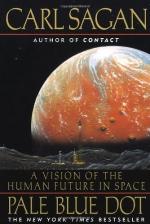
|
| Name: _________________________ | Period: ___________________ |
This test consists of 15 multiple choice questions and 5 short answer questions.
Multiple Choice Questions
1. What moon was found to have volcanoes?
(a) Terpsichore.
(b) Europa.
(c) Io.
(d) Persephone.
2. What is the main component of the atmosphere of Venus?
(a) Hydrogen.
(b) Sulfuric acid.
(c) Quicklime gas.
(d) Phosphate.
3. CFCs are chemicals that is primarily hazardous to the environment in what area?
(a) The biosphere.
(b) The lithosphere.
(c) The ozone-layer.
(d) The stratosphere.
4. Sagan discusses in detail a theory that Saturn's rings are caused by what effect?
(a) Gravity waves.
(b) Cosmic perturbation.
(c) Ether condensation.
(d) Planetary tides.
5. Where was NASA's first SETI facility located?
(a) The Mojave desert.
(b) The Appalachian mountain range.
(c) The Sierra Nevada mountain range.
(d) The Nevada salt flats.
6. According to Sagan, what was the major advantage of the attitude of the government towards the Apollo project?
(a) Rocket science progressed quickly.
(b) There was plenty of funding for space.
(c) New propulsion systems were developed.
(d) Computers advanced in power rapidly.
7. Why does Sagan say that Mars is a more desirable target for human exploration than the moon?
(a) It is more inhabitable.
(b) It has more to teach.
(c) It is more like Earth.
(d) It has more resources.
8. What types of information does SETI analyze?
(a) Magnetic waves.
(b) Gravitational waves.
(c) Cosmic rays.
(d) Radio waves.
9. Which of the following is one of the moons of Mars?
(a) Hecuba.
(b) Orpheus.
(c) Phobos.
(d) Gilgamesh.
10. According to Sagan, how profitable is it for a nation to invest in space exploration?
(a) It has high costs.
(b) It is not related to a nation's welfare.
(c) It has great benefits in a limited scope.
(d) It is highly profitable.
11. When does Sagan think that the human race will be "on its way"?
(a) When we begin colonizing other planets.
(b) When we make contact with another intelligent species.
(c) When we begin living in space.
(d) When we reach another star.
12. What fuel source might be viable within asteroids?
(a) Bacteria byproducts.
(b) Methane.
(c) Hexane.
(d) Organic solids.
13. What is the shape of the galaxy closest to the Milky Way?
(a) Globular.
(b) Disc.
(c) Spiral.
(d) Cluster.
14. When did the belief that Venus was a "sister planet" to Earth become dispelled?
(a) The early twentieth century.
(b) The mid nineteenth century.
(c) The mid twentieth century.
(d) The late nineteenth century.
15. The atmosphere of Venus would best be described as which of the following?
(a) Thick.
(b) Light.
(c) Deep.
(d) Cold.
Short Answer Questions
1. What was the name of the second mission that sent probes into the atmosphere of Venus?
2. What is the acronym for the project within SETI that Sagan worked on?
3. Sagan estimates that intelligent life might arise on average in one out of how many stars?
4. At the time this book was written, how many Mars Observers had been flown successfully?
5. How does Sagan characterize most of the benefits gleaned from the space programs of the 60s and 70s?
|
This section contains 462 words (approx. 2 pages at 300 words per page) |

|




